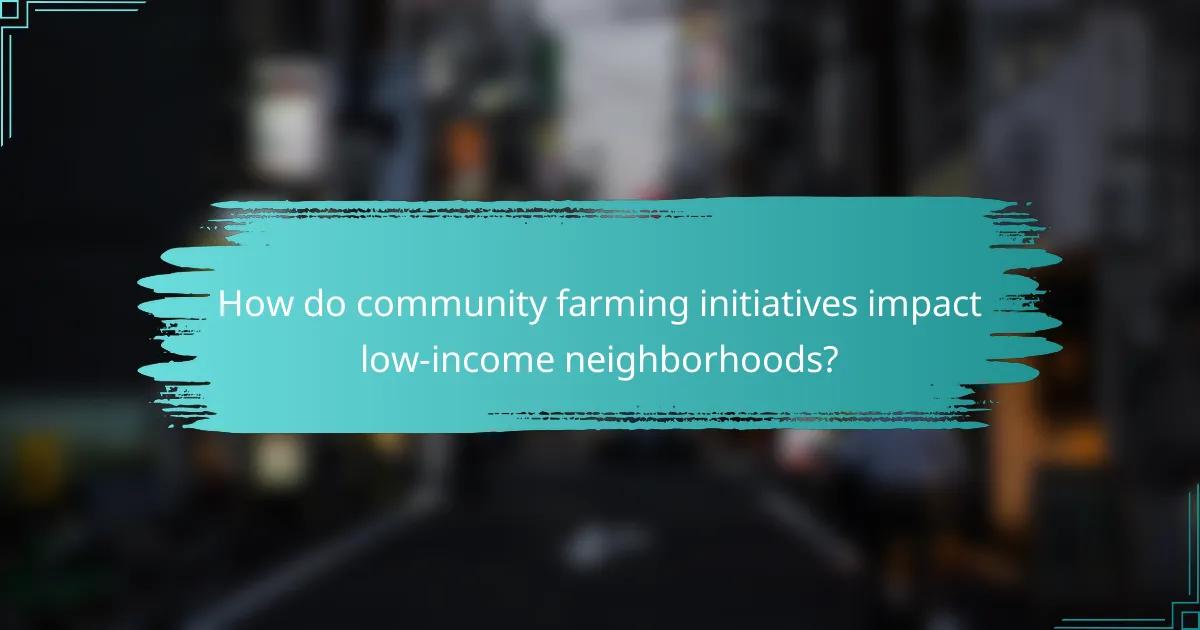Community farming initiatives play a crucial role in transforming low-income neighborhoods by enhancing access to fresh food and fostering social connections. By generating jobs and supporting local businesses, these programs stimulate economic growth while addressing food insecurity, ultimately contributing to a more sustainable local economy.

How do community farming initiatives impact low-income neighborhoods?
Community farming initiatives significantly enhance low-income neighborhoods by improving access to fresh food, fostering social ties, and stimulating local economies. These initiatives create opportunities for residents to engage in agriculture, which can lead to various positive outcomes for the community.
Increased access to fresh produce
Community farming initiatives provide low-income neighborhoods with direct access to fresh fruits and vegetables, which are often scarce in food deserts. By establishing local gardens or farms, residents can obtain nutritious food at lower prices, reducing reliance on processed options.
These initiatives often include educational programs about healthy eating and cooking, further empowering residents to make better dietary choices. For example, a community garden might offer workshops on how to prepare meals using the produce grown on-site.
Enhanced community cohesion
Community farming fosters a sense of belonging and collaboration among residents. Working together on shared gardening projects encourages social interaction, builds trust, and strengthens relationships within the neighborhood.
Events such as harvest festivals or farmers’ markets can further enhance community ties by bringing people together to celebrate their collective achievements. This social capital can lead to increased civic engagement and a more supportive environment for residents.
Improved local economy
Community farming initiatives can stimulate the local economy by creating jobs and supporting local businesses. These farms often require labor for planting, maintenance, and harvesting, providing employment opportunities for residents, particularly in areas with high unemployment rates.
Additionally, local farms can supply nearby restaurants and grocery stores, keeping money within the community. This cycle of local spending can lead to a more resilient economy, where residents benefit from the growth and sustainability of their neighborhood.

What are the economic benefits of community farming?
Community farming offers several economic benefits, particularly in low-income neighborhoods. These initiatives can generate jobs, support local businesses, and help alleviate food insecurity, creating a more sustainable local economy.
Job creation in urban areas
Community farming initiatives can significantly contribute to job creation in urban areas by providing employment opportunities in agriculture, distribution, and retail. Positions may include farm workers, managers, and sales staff, often targeting local residents who may face barriers to traditional employment.
These jobs not only provide income but also enhance skills in areas such as horticulture, business management, and customer service. Programs that focus on training and development can further empower individuals, leading to long-term career advancements.
Boosting local businesses
Community farming can stimulate local economies by increasing demand for goods and services from nearby businesses. Farmers’ markets and local produce stands often attract customers who then visit surrounding shops, benefiting the entire community.
Additionally, partnerships between community farms and local restaurants or grocery stores can create a steady market for fresh produce, fostering a collaborative environment that supports economic growth. This interconnectedness can lead to a more resilient local economy.
Reducing food insecurity
By increasing access to fresh, affordable produce, community farming plays a crucial role in reducing food insecurity, particularly in underserved neighborhoods. These farms often provide low-cost or subsidized food options, making healthy eating more accessible.
Furthermore, educational programs associated with community farms can teach residents about nutrition and cooking, empowering them to make healthier food choices. This holistic approach not only addresses immediate food needs but also promotes long-term health and well-being in the community.

How can community farming initiatives create jobs?
Community farming initiatives create jobs by engaging local residents in agricultural activities, providing training, and fostering partnerships that enhance employment opportunities. These initiatives not only support food security but also stimulate economic growth in low-income neighborhoods.
Training programs for residents
Training programs equip residents with essential skills needed for agricultural work, including crop management, pest control, and sustainable farming practices. These programs often last several weeks and can be tailored to meet the specific needs of the community.
By offering hands-on experience and workshops, participants gain confidence and improve their employability. Local governments or non-profits frequently sponsor these initiatives, making them accessible and affordable.
Partnerships with local organizations
Partnerships with local organizations, such as schools, non-profits, and agricultural cooperatives, enhance the effectiveness of community farming initiatives. These collaborations can provide resources, funding, and expertise, which are crucial for successful job creation.
For instance, a local non-profit might offer grants for community gardens, while a school could integrate agricultural education into its curriculum, creating a pipeline of skilled workers. Such synergies not only boost employment but also strengthen community ties.
Employment opportunities in agriculture
Community farming initiatives generate various employment opportunities, ranging from farm labor to management positions. These jobs can be part-time or full-time, catering to different skill levels and availability.
Additionally, as the demand for locally sourced produce increases, new roles in marketing, distribution, and food processing may emerge. This diversification helps stabilize the local economy and provides residents with sustainable income sources.

What are successful examples of community farming in the United States?
Successful community farming initiatives in the United States demonstrate how local agriculture can enhance food security, create jobs, and foster economic development in low-income neighborhoods. These programs often involve collaboration among residents, local organizations, and government entities to maximize their impact.
Detroit Black Community Food Security Network
The Detroit Black Community Food Security Network focuses on empowering local residents to take control of their food systems. By establishing urban farms and community gardens, they provide fresh produce while educating the community about sustainable practices.
This initiative not only addresses food deserts but also creates job opportunities in agriculture and related fields. Participants often gain skills in farming, marketing, and nutrition, which can lead to further employment in the growing local food economy.
Green City Growers in Cleveland
Green City Growers operates a large-scale urban farm in Cleveland, producing a variety of vegetables for local markets. This initiative emphasizes the importance of local food production, aiming to reduce reliance on imported goods and enhance food sovereignty.
By employing residents and offering training programs, Green City Growers contributes to job creation in the area. Their model showcases how urban agriculture can be both economically viable and socially beneficial, providing fresh food while stimulating the local economy.
Urban Farm in Atlanta
The Urban Farm in Atlanta serves as a model for integrating agriculture into urban settings. This initiative focuses on community engagement, offering workshops and volunteer opportunities that educate residents about sustainable farming techniques.
By fostering a sense of community and providing access to fresh produce, the Urban Farm enhances food security in the area. Additionally, it creates job opportunities in farming and food distribution, contributing to the local economy and promoting healthier lifestyles.

What factors contribute to the success of community farming initiatives?
Successful community farming initiatives rely on several key factors, including strong community engagement, access to funding, and collaboration with local governments. These elements help create sustainable models that not only provide food but also foster economic growth and job creation in low-income neighborhoods.
Community engagement and support
Community engagement is crucial for the success of farming initiatives, as it ensures local residents are actively involved and invested in the project. This can include organizing volunteer days, educational workshops, and regular meetings to gather feedback and ideas.
Building a sense of ownership among community members can lead to better maintenance of the farms and increased participation. Initiatives that incorporate local culture and traditions often see higher levels of support and enthusiasm.
Access to funding and resources
Access to funding is essential for launching and sustaining community farming initiatives. Potential sources include grants from non-profits, local government programs, and crowdfunding campaigns. Establishing a clear budget and financial plan can help attract these resources.
Additionally, securing partnerships with local businesses can provide both financial support and in-kind donations, such as tools or seeds. It’s important to research available funding opportunities and apply early, as many grants have specific deadlines.
Collaboration with local governments
Collaboration with local governments can enhance the viability of community farming initiatives by providing necessary support and resources. Local authorities may offer land access, technical assistance, or regulatory guidance to help navigate zoning laws and health regulations.
Engaging with local government officials can also lead to greater visibility and legitimacy for the initiative. Forming advisory boards that include government representatives can facilitate ongoing communication and support, ensuring that the farming project aligns with community development goals.

How do community farming initiatives address food deserts?
Community farming initiatives tackle food deserts by providing local access to fresh produce and nutritious food options. These programs often transform vacant lots into productive gardens, improving food security and fostering healthier eating habits in underserved neighborhoods.
Economic Impact of Community Farming
Community farming can stimulate local economies by creating jobs and supporting small businesses. These initiatives often require labor for planting, maintenance, and harvesting, which can lead to employment opportunities for residents, particularly in low-income areas.
Additionally, community farms can reduce food costs by providing affordable produce directly to consumers. By cutting out middlemen, these farms can offer lower prices than traditional grocery stores, making healthy food more accessible.
Benefits for Low-Income Neighborhoods
In low-income neighborhoods, community farming initiatives can significantly improve access to fresh fruits and vegetables. By establishing local gardens, these programs address the lack of grocery stores and supermarkets, which often leads to reliance on convenience stores with limited healthy options.
Moreover, community farms can promote social cohesion by bringing residents together for shared goals. This collaboration fosters a sense of community and encourages local engagement, which can lead to further improvements in neighborhood conditions.
Job Creation Through Community Farming
Community farming initiatives create jobs in various roles, from agricultural work to administrative positions. These jobs can be particularly beneficial for individuals facing barriers to employment, such as lack of experience or education.
Programs often include training and skill development, equipping participants with valuable knowledge in sustainable farming practices and business management. This not only enhances their employability but also contributes to the long-term sustainability of the initiative.
